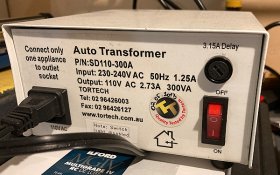If you want to go whole hog you can buy devices that will convert from one voltage/frequency to another. They are expensive. Here's one example. There might be less expensive options out there as well.
http://www.gohz.com/single-phase-frequency-converter
By the way, one option might be to buy a small self-contained solar power unit with battery storage. I haven't looked into the issue of whether these are available with 110V/60Hz output or what the cost would be. For operating your darkroom something might that might provide plenty of output.
As mentioned by others, most likely your lowest cost option would be to buy new bulbs for your enlarger and then replace the timers with units that will work in Australia. If you want to go that route then sell your timers on ebay before you move to Australia. That will help defray the cost of buying new timers when you get there.
Have you looked at the labels on all of the electrical equipment you are planning to move with you? Make a list of what the voltage/frequency requirement is for each one. As others have mentioned, some might have very flexible power requirements, especially some equipment made in recent years. Some might have strict voltage/frequency requirements. Those are the ones you want to pay attention to. Then decide whether it is cheaper to replace those units or buy something that can condition the available power to what you need for your devices. For the most part it will only be the ones that either derive timing information from the power mains or use a motor that turns at a rate determined buy the power mains.
Maybe you could make a list of the power requirements and then group them together and post the list here.
With regard to the rpm of motors, the only ones you would need to worry about would be be synchronous motors or induction motors. Those are the kinds which have a shaft rpm that depends on frequency. Of those, synchronous motors are the only ones that would be used if the rpm needs to be very strictly controlled, such as timer motors. The rpm of an induction motor changes slightly, depending on the load.
Anything that involves a pure heating function (ordinary incandescent light bulbs might be an honorary member of that club) is not going to be very frequency-dependent. 50Hz should work about as well as 60Hz. For anything that is not frequency dependent a simple transformer should suffice, which means that a simple transformer should work, including the one at Amazon that you linked, provided that 10 Amp output is enough. (It probably is enough.)
There's another trick that might work, but I don't know if it would work for sure. If the power coming out of the plug has two hot wires plus a ground you could rig up a device that would just one leg of the power plus ground. Most likely the power plugs have on hot and one neutral, plus ground. In that case this scheme won't work. If the power plug does have two hot wires you would have to see if that violated any power electrical codes in Australia by using just one leg of the power.
An even wilder option would be to buy a small portable generator with 110V/60Hz output.







